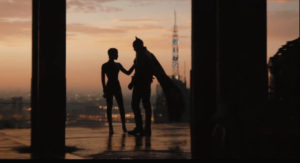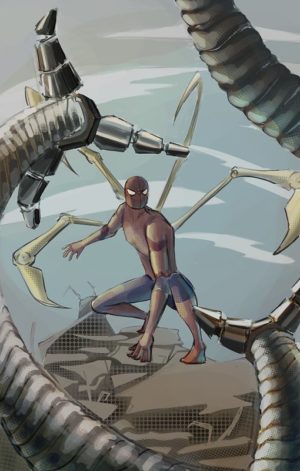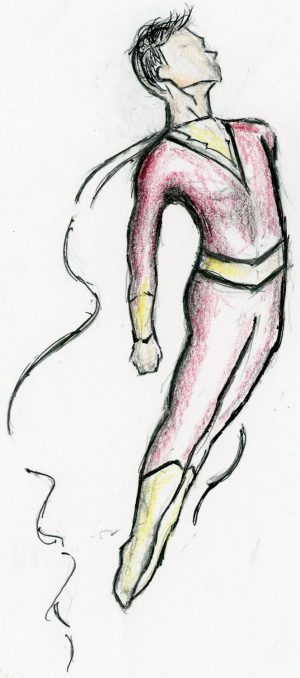“The Batman”: a love letter to the comics
Robert Pattinson’s Batman embodies the true spirit of the character.
April 25, 2022
Robert Pattinson, who plays the titular character in the 2022 film “The Batman,” directed by Matt Reeves, does not — despite what the name suggests — carry a bat around with him. This is very disappointing.
The rest of the film however, more than makes up for the oversight. It’s dark, dramatic, and gritty — all in the ways Batman should be. It takes itself seriously as a Batman movie and feels no shame in its comic book origins in off-brand Chicago.
What you get is an end product that is a lot more real, a lot more ridiculous, and so much more enjoyable for it all.
Cinematography and Design
Perfecting a Gotham that doesn’t ruin all immersion is a Herculean task. Make it too campy, and the characters fade into the city. Make it too realistic, and Batman seems out of place. Hitting the sweet spot between both the vibrant drama and the comical gravitas alive is almost impossible, but cinematographer Greig Fraser strikes a masterful balance of the two with one key element: lighting.
Batman is a character defined by shadows — he opens the film telling the audience this himself. And with the use of shadows comes the noir edge that is essential to Batman. Every shadow and every light is purposeful. Batman does not blend into the backdrop, as if he means nothing to the city. He does not stand out, either, like he is cartoonishly out of place in a city that hits too close to home. The lighting makes him a key but unique player in Reeves’ Gotham City.
This Gotham is an amalgamation of every Gotham ever seen on screen. Though it feels grounded, it still has that dramatic element that lets the viewer suspend their disbelief. The cityscape combines elements of gothic and modern architecture in perfect harmony. The restricted use of CGI in favor of dramatic sets makes everything so much more authentic. Through the masterful use of color and light, the city has never felt more alive.
Movies
There can be no review without acknowledging the artistry of Matt Reeves. His experience with Planet of the Apes shows his ability to take pre-existing franchises and make them his own. He’s no stranger to taking a larger than life premise and making it feel right at home.
Most people say the movie is grounded. These people are right, in the sense that the antagonists are treated respectfully, but wrong in the tone of the movie — it wasn’t grounded. It still felt like a comic book. It still felt like Batman.
We haven’t seen many comic book movies master this before. The Dark Knight was praised for its realism, but it was just too real. It made Batman feel out of place because the premise of Batman — a rich guy dressed as a bat that beats people up — is already ridiculous and unreal. The Dark Knight doesn’t feel like a Batman movie; it feels like a Nolan movie with Batman in it.
Other adaptations are pretty much the same. Burton’s Batman movies are Burton movies with Batman in them, Snyder superhero movies are Snyder movies with superheroes in them, and the list goes on. Snyder came the closest to Reeves in terms of good ideas behind the concepts, but he tries so hard to be edgy that the immersion is ruined three minutes in when you’re reminded it’s a Zack Snyder movie.
Besides Reeves, the only other person who managed to adapt a movie faithfully to the comics was Raimi, with the original Spider-Man films. The heart of the two franchises are tied to the characters they are about. “The Batman” cares about the source material. It wasn’t about doing it better, or doing it differently. “The Batman” knows exactly what it is: a Batman movie. It is a love letter to the comics and every Batman that came before.
Comics
Let’s face it: comic book adaptations usually suck. “Batman” steps away from the MCU effect that’s pervaded common perception of what a superhero movie should be like. Notably, the turn away from CGI in the film and the appeal of consumerist mass marketed media.
The movie takes inspiration from “Long Halloween” and the more mystery-noir-detective type Bats. Reeves adapts them beautifully into film whilst still having classic Batman fight scenes.

Bruce Wayne
Robert Pattinson’s penchant for only playing what he considers to be “total freaks” is a well documented phenomenon. His approach to playing Batman is an integral part of his understanding of the character and the way he portrays him so well.
We meet his Batman in his second year as the dark knight — a unique start to this universe. This Bruce is one who hasn’t realized his power outside of the cowl. He’s dedicated to his identity as Batman, and puts little effort in his life as a Wayne. Pattinson, in contrast, is fully committed to both roles. His performance isn’t over-the-top: it’s subtle compared to past incarnations. He speaks more with his eyes than through dialogue, making him come across as more genuine.
All subtlety is lost, however, when it comes to the dialogue. The script is unabashedly a Batman script, and Pattinson treats it as such. He commits to the drama with grave seriousness that would come across as cartoonish if done even a little differently. He makes it work. The theatrics feel perfectly in place and don’t destroy the sense of realism.
Pattinson’s Batman voice just adds to the comical solemness of the script. Though he initially opted for a quiet, whisper-like voice, Reeves led him towards the sound we hear in the film. It’s reminiscent of Christian Bale’s take, who also wanted to speak a little softer. You can really tell how hard Pattinson tries with this voice. It’s phenomenal, of course, but it’s still pretty cliche, especially with the dialogue. But Pattinson keeps this from becoming too campy. The balance of corniness and dramatics make his Batman feel like a comic book hero in all the best ways.
His take on Bruce, like his take on Batman, is unique in its balance. He isn’t an extroverted playboy, nor is he completely alone. His Bruce is someone still learning what he can do and what he wants to do. We follow him on a much needed and delayed coming of age story, where he grows into his place in Gotham’s legacy. “The Batman” is more of an origin story for the man behind the mask than the caped crusader. He’s on the road to becoming the familiar billionaire we’ve seen countless times before, but in a much more realistic and thoughtful way.
Alfred
Andy Serkis proves one thing: you can never have a bad Alfred.
For a character defined by his love for his parents, Batman rarely has his relationship with his pseudo father given much importance in adaptations. “The Batman” makes this strained relationship one of the focal points of the film, though much is left unsaid.
It is clear how much time and care went into this Alfred from his first entrance. His scars, cane, and willingness to fight with Bruce speak to an unseen past viewers can piece together. This Alfred is not the loyal butler we are familiar with, but he still holds the same love for Bruce as his predecessors.
The relationship between Bruce and Alfred is more complex than prior adaptations. This is an Alfred who wants the best for Bruce, and will make it clear when he is disappointed. He feels at the same time responsible for the man Bruce has become and completely disconnected.
Despite his little screen time in comparison to others, Serkis has one of the strongest acts in the film. Every scene he appears in feels heavy. Watching Alfred and Bruce’s relationship unfold was one of the highlights of “The Batman.”
Selina Kyle
Zoe Kravitz is The Zoe Kravitz. We can’t say anything that hasn’t been said before. She’s a phenomenal actress who gives it her all as Selina Kyle. Talented, brilliant, incredible, amazing, show stopping, spectacular, etc.
The acting was already stunning, but narratively? Zoe Kravitz’s Selina in her pre-Catwoman, still-a-criminal era is a welcome change from her usual appearances. Adaptations and even the source material rarely give her agency outside of her relationship with Batman. Kravitz adds much appreciated depth to the often one-note femme fatale. She is wonderful, as expected, and such a three dimensional character, introduced onscreen when trying to protect her girlfriend.
Kravitz and Pattinson’s chemistry is immediately apparent and makes for a strong pairing. Kravitz’s performance takes the romance from cliche to convincing. Their relationship is taken as seriously as the overall storyline, giving it the time it needs to feel as grounded as the entire film.
Antagonists
You can’t have a good Batman story without a convincing villain. Gotham’s “Rogues’ Gallery” has some of the most iconic antagonists in pop culture history. It’s a lot to live up to — but Reeves meets this challenge head on.
Paul Dano’s Riddler is a breath of fresh air — or, more accurately, an anxious gasp. It’s been decades since we’ve seen some genuinely terrifying villains in comic book movies, and Dano’s take on the classic rogue is beyond unsettling.
Reeves based this Riddler on the Zodiac Killer, which could have gone wrong very quickly. But Dano’s acting on top of a strong script makes this character simultaneously real and larger than life.
The costume design in particular added to this feel. The horror-inspired outfit was designed by Dano himself. Though it isn’t the green suit or leotard many are familiar with, the Riddler still looks like a comic book villain. The ensemble is a little more fitting against the dark Gotham backdrop while still being fun and imaginative like a good Batman villain should be.
But having just one rogue isn’t enough. This is Gotham, after all. And while “The Batman” isn’t an origin for the Bat or the Riddler, it does tease at some well known villains taking their first steps into the world of crime.
Zoë Kravitz’s Catwoman is the heart of the film. This Selina Kyle hasn’t taken on her moniker, but it’s clear that it is inevitable. Kravitz focuses more on portraying Selina as a person than her persona, but does tease at the character’s potential.
Similarly, Colin Farrell’s Penguin isn’t the adversary he’s known as just yet. He’s still a lower rank in the mob world, seemingly insignificant. But Farell steals the spotlight every time he comes on screen. He’s a hilarious underdog who you can’t help but root for.
Others are also hinted at throughout the film. The many references to the Court of Owls, both in small lines and deeper in the plot, point to a strong future adversary that both Reeves and Pattinson have expressed interest in. And, of course, there was the Joker reveal. Though the Clown Prince of Crime has yet to take his throne, his short cameo was clear and memorable.
Soundtrack
A technical masterpiece and just fun to listen to, the soundtrack offers an insight into the characters and their mental states during the events of the film. Batman being a Nirvana-listening Hamlet-esque loser is a need.
The film opens with the lofty strains of Schubert’s classic “Ave Maria,” which distorts as Riddler commits his crimes. Though it adds environmentally to the meaning of the scene, it’s a little too classic. Even the back-up singers in the form of siren wails are familiar to anybody who’s watched “Boondock Saints,” or even the first season of “West Wing”. Though the drama of “Ave Maria” being played over brutally violent scenes doesn’t fade through its countless iterations, it’s a cheap fallback into cinematic shorthand for its safe, tried-and-true ironic irreverence.
Michael Giacchino steals the show with his chilling score. The Gotham backdrop comes to life with his gloomy but powerful themes. Every scene stands out because of his music. It only highlights the drama and tragedy that is Batman. The key to a thriller is a strong score, and Giacchino hits it out of the park.
Final Thoughts
The film’s exploration of wealth and the source of evil in Gotham was refreshing to see on the big screen. The third act’s finish is quintessential Batman, giving the movie an ending right where it should end, closing with a sense of finality while giving space for a sequel.
It also brings up the possibility of a future Robin. It fits thematically: Batman doesn’t understand all parts of Gotham, which is one of the things that sets him at odds with Catwoman, but when he picks up his child slash sidekick Robin, he grows to understand the many facets of the city he protects. And with both Robert and Reeves expressing an interest in Robin, the possibility of a future sequel isn’t too far away.
The film truly shows that Batman is about Batman, not fighting and not the villains. The ending captured that perfectly while giving each character a fitting resolution. There wasn’t a giant battle just for the sake of giving the audience a gratuitous fight scene, but rather a conclusion that brought closure to the narrative and to the characters. And the credits are simply gorgeous.





